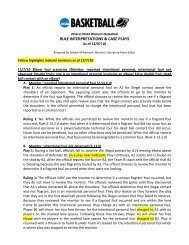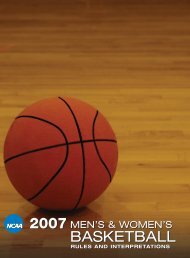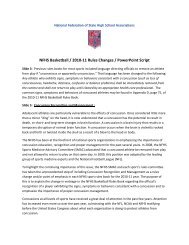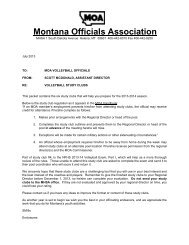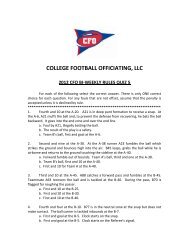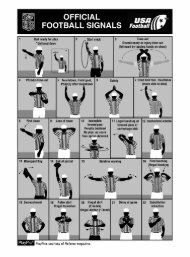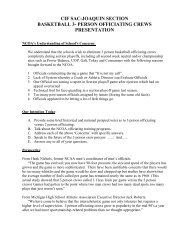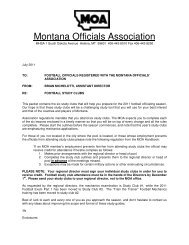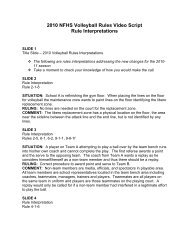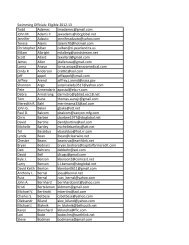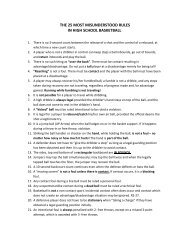2011-12 AND 2012-13 MEN'S AND WOMEN'S RULES - NAIA
2011-12 AND 2012-13 MEN'S AND WOMEN'S RULES - NAIA
2011-12 AND 2012-13 MEN'S AND WOMEN'S RULES - NAIA
Create successful ePaper yourself
Turn your PDF publications into a flip-book with our unique Google optimized e-Paper software.
RULE 4 / DEFINITIONS55<br />
b. The entire ball is above the level of the ring and has the possibility, while<br />
in flight, of entering the basket and is not touching the cylinder.<br />
Art. 2. It is goaltending to touch the ball outside the cylinder during a free throw,<br />
regardless of whether the free throw is on its upward or downward flight.<br />
Art. 3. When the entire ball is above the level of the ring during a field-goal try<br />
and contacts the backboard, it is considered to be on its downward flight. In such<br />
a case, it is goaltending when the ball is touched by a player.<br />
Section 35. Guarding<br />
Art. 1. Guarding shall be the act of legally placing the body in the path of an<br />
offensive opponent. The guarding position shall be initially established and then<br />
maintained inbounds on the playing court.<br />
Art. 2. There is no minimum distance required between the guard and opponent,<br />
but the maximum shall be (men) 6 feet or (women) 3 feet when closely guarded.<br />
This distance shall be measured from the forward foot or feet of the defender to<br />
the forward foot or feet of the opponent. These distances shall apply only when<br />
a player, (men) in the front court, is holding the ball or dribbling or (women) is<br />
holding the ball anywhere on the playing court.<br />
Art. 3. Every player shall be entitled to a spot on the playing court, provided that<br />
such player gets there first without illegally contacting an opponent. (Exception:<br />
Rule 4-35.7)<br />
Art. 4. To establish an initial legal guarding position on the player with the ball:<br />
a. The guard shall have both feet touching the playing court. When the guard<br />
jumps into position initially, both feet must return to the playing court after<br />
the jump, for the guard to attain a legal guarding position.<br />
b. The guard’s torso shall face the opponent.<br />
c. No time and distance shall be required.<br />
d. When the opponent with the ball is airborne, the guard shall have attained<br />
legal guarding position before the opponent left the playing court.<br />
(Exception: Rule 4-35.7)<br />
Art. 5. To establish legal guarding position on a player without the ball:<br />
a. Time and distance shall be required to attain an initial legal guarding<br />
position;<br />
b. The guard shall give the opponent the time and distance to avoid contact;<br />
c. The distance given by the opponent of the player without the ball need not<br />
be more than two strides; and<br />
d. When the opponent is airborne, the guard shall have attained legal<br />
guarding position before the opponent left the playing court.<br />
Art. 6. To maintain a legal guarding position after the initial position has been<br />
attained, the guard:<br />
a. Is not required to continue having the torso face the opponent;<br />
b. Is required to have either one foot or both feet on the playing court (cannot<br />
be out of bounds);<br />
c. May raise the hands or may jump within his or her own vertical plane;




